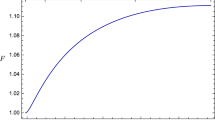Abstract
We propose an efficient analytical method for estimating the luminosity distance in a homogenous Friedmann-Lemaître-Robertson-Walker (FLRW) model of the Universe. This method is based on the homotopy perturbation method (HPM) which has a high accuracy in many nonlinear problems and can be easily implemented. For an analytical calculation of the luminosity distance, we suggest to proceed not from computation of the integral which determines it but from the solution of a certain differential equation with the corresponding initial conditions. Solving this equation by means of HPM, we obtain approximate analytical expressions for the luminosity distance as a function of the redshift for two different types of homotopy. A possible extension of this method to other cosmological models is also discussed.
Similar content being viewed by others
References
A. G. Riess et al., Astron. J. 116, 1009 (1998).
S. Perlmutter et al., Astrophys. J. 517, 565 (1999).
N. Suzuki, D. Rubin, C. Lidman et al., Astrophys. J. 746, 85 (2012).
De-Zi Liu, Cong Ma, Tong-Jie Zhang, and Zhiliang Yang, Mon. Not. R. Astron. Soc. 412, 2685 (2011).
Céline Cattoën and Matt Visser, Class. Quantum Grav. 24, 5985 (2007).
Ue-Li Pen, Astrophys. J. Suppl. 120, 49–50 (1999).
A. Meszaros and J. Ripa, Astron. Astrophys. 573, A54 (2015).
Hao Wei, Xiao-Peng Yan, and Ya-Nan Zhou, JCAP 1401, 045 (2014).
J.-H. He, Comput.Meth. Appl.Mech. Eng. 178, 257 (1999).
J.-H. He, Int. J. Nonlin. Mech. 35 (1), 37 (2000).
J.-H. He, Appl. Math. Comput. 135, 73 (2003).
J.-H. He, Indian J. Phys. 88 (2), 193 (2014).
J.-H. He, Abstract and Applied Analysis, 2012, Article ID 916793, 130 pages. DOI:10.1155/2012/916793
L. Cveticanin, Chaos Soliton Fract. 30 (5), 1221 (2006).
M. Zare, O. Jalili and M. Delshadmanesh, Indian. J. Phys. 86 (10), 855 (2012).
V. Shchigolev, Universal J. Appl. Math. 2 (2), 99 (2014).
F. Rahaman, S. Ray, A. Aziz, S. R. Chowdhury, and D. Deb, arXiv: 1504.05838.
S. Weinberg, Gravitation and Cosmology: Principles and Applications of The General Theory of Relativity (JohnWiley, New York, 1972).
T. Wickramasinghe and T. N. Ukwatta, Mon. Not. R. Astron. Soc. 406, 548 (2010).
T. Chiba and T. Nakamura, Prog. Theor. Phys. 100, 1077 (1998).
M. Visser, Class. Quantum Grav. 21, 2603 (2004).
M. Visser, Gen. Rel. Grav. 37, 1541 (2005).
Author information
Authors and Affiliations
Corresponding author
Additional information
Plenary talk given at the International Schoool-Seminar on Theoretical and Observational Cosmology GRACOS-2016, September 19–30, 2016, Ulyanovsk, Russia.
Rights and permissions
About this article
Cite this article
Shchigolev, V.K. Calculating luminosity distance versus redshift in FLRW cosmology via homotopy perturbation method. Gravit. Cosmol. 23, 142–148 (2017). https://doi.org/10.1134/S0202289317020098
Received:
Accepted:
Published:
Issue Date:
DOI: https://doi.org/10.1134/S0202289317020098



